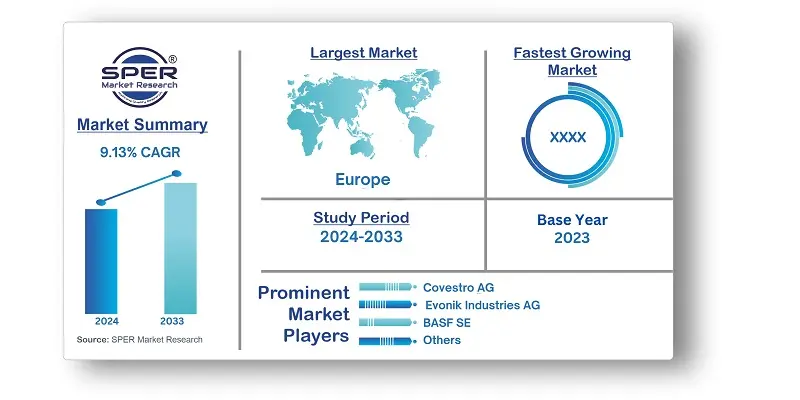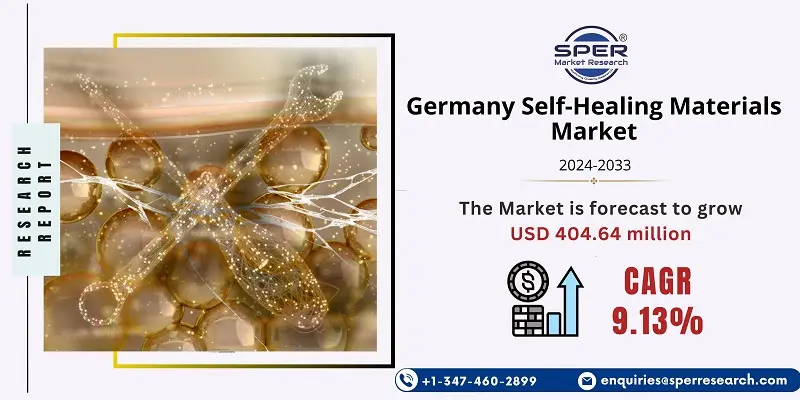
Germany Self-Healing Materials Market Growth, Size, Trends, Share, Demand and Future Outlook
Germany Self-Healing Materials Market Size- By Form, By Material Type, By End User- Regional Outlook, Competitive Strategies and Segment Forecast to 2033
| Published: Jul-2024 | Report ID: CHEM2473 | Pages: 1 - 102 | Formats*: |
| Category : Chemical & Materials | |||
- July 2021: The Engineering and Physical Sciences Research Council, a division of UK Research and Innovation, announced a partnership and an estimated USD 22.5 million investment in the development of sustainable road repair projects.
- February 2019: A research team from RIKEN and Kyushu University developed a unique ethylene-based polymer with a variety of useful properties, including self-healing and shape memory. Surprisingly, several of the materials may self-repair when exposed to water or acidic or alkaline solutions.


| Report Metric | Details |
| Market size available for years | 2020-2033 |
| Base year considered | 2023 |
| Forecast period | 2024-2033 |
| Segments covered | By Form, By Material Type, By End-Use |
| Regions covered | Eastern Region, Western Region, Southern Region, Northern Region |
| Companies Covered | Covestro AG, Evonik Industries AG, BASF SE, Wacker Chemie AG, CETEC-GmbH. |
- Automotive Manufacturers
- Aerospace Companies
- Construction and Infrastructure Firms
- Electronics and Semiconductor Companies
- Medical Device Manufacturers
- Research and Development Institutions
- Material Science Laboratories
- Packaging Industry
- Energy and Utility Companies
- Paints and Coatings Manufacturers
| By Form: |
|
| By Material Type: |
|
| By End-Use: |
|
- Germany Self-Healing Materials Market Size (FY’2024-FY’2033)
- Overview of Germany Self-Healing Materials Market
- Segmentation of Germany Self-Healing Materials Market By Form (Extrinsic, Intrinsic)
- Segmentation of Germany Self-Healing Materials Market By Material Type (Polymer, Concrete, Coatings, Others)
- Segmentation of Germany Self-Healing Materials Market By End-Use (Building & Construction, Mobile Devices, Transportation, Others)
- Statistical Snap of Germany Self-Healing Materials Market
- Expansion Analysis of Germany Self-Healing Materials Market
- Problems and Obstacles in Germany Self-Healing Materials Market
- Competitive Landscape in the Germany Self-Healing Materials Market
- Impact of COVID-19 and Demonetization on Germany Self-Healing Materials Market
- Details on Current Investment in Germany Self-Healing Materials Market
- Competitive Analysis of Germany Self-Healing Materials Market
- Prominent Players in the Germany Self-Healing Materials Market
- SWOT Analysis of Germany Self-Healing Materials Market
- Germany Self-Healing Materials Market Future Outlook and Projections (FY’2024-FY’2033)
- Recommendations from Analyst
1.1. Scope of the report1.2. Market segment analysis
2.1. Research data source2.1.1. Secondary Data2.1.2. Primary Data2.1.3. SPER’s internal database2.1.4. Premium insight from KOL’s2.2. Market size estimation2.2.1. Top-down and Bottom-up approach2.3. Data triangulation
4.1. Driver, Restraint, Opportunity and Challenges analysis
4.1.1. Drivers4.1.2. Restraints4.1.3. Opportunities4.1.4. Challenges4.2. COVID-19 Impacts of the Germany Self-Healing Materials Market.
5.1. SWOT Analysis5.1.1. Strengths5.1.2. Weaknesses5.1.3. Opportunities5.1.4. Threats5.2. PESTEL Analysis5.2.1. Political Landscape5.2.2. Economic Landscape5.2.3. Social Landscape5.2.4. Technological Landscape5.2.5. Environmental Landscape5.2.6. Legal Landscape5.3. PORTER’s Five Forces5.3.1. Bargaining power of suppliers5.3.2. Bargaining power of buyers5.3.3. Threat of Substitute5.3.4. Threat of new entrant5.3.5. Competitive rivalry5.4. Heat Map Analysis
6.1. Germany Self-Healing Materials Market Manufacturing Base Distribution, Sales Area, Product Type6.2. Mergers & Acquisitions, Partnerships, Product Launch, and Collaboration in Germany Self-Healing Materials Market
7.1. Germany Self-Healing Materials Market Size, Share and Forecast, By Form, 2020-20267.2. Germany Self-Healing Materials Market Size, Share and Forecast, By Form, 2027-20337.3. Extrinsic7.4. Intrinsic
8.1. Germany Self-Healing Materials Market Size, Share and Forecast, By Material Type, 2020-20268.2. Germany Self-Healing Materials Market Size, Share and Forecast, By Material Type, 2027-20338.3. Polymer8.4. Concrete8.5. Coatings8.6. Others
9.1. Germany Self-Healing Materials Market Size, Share and Forecast, By End-Use, 2020-20269.2. Germany Self-Healing Materials Market Size, Share and Forecast, By End-Use, 2027-20339.3. Building & Construction9.4. Mobile Device9.5. Transportation9.6. Others
10.1. Germany Self-Healing Materials Market Size and Market Share
11.1. Germany Self-Healing Materials Market Size and Market Share By Region (2020-2026)11.2. Germany Self-Healing Materials Market Size and Market Share By Region (2027-2033)11.3. Eastern Region11.4. Western Region11.5. Southern Region11.6. Northern Region
12.1. Covestro AG12.1.1. Company details12.1.2. Financial outlook12.1.3. Product summary12.1.4. Recent developments12.2. Evonik Industries AG12.2.1. Company details12.2.2. Financial outlook12.2.3. Product summary12.2.4. Recent developments12.3. BASF SE12.3.1. Company details12.3.2. Financial outlook12.3.3. Product summary12.3.4. Recent developments12.4. Wacker Chemie AG12.4.1. Company details12.4.2. Financial outlook12.4.3. Product summary12.4.4. Recent developments12.5. CETEC-GmbH12.5.1. Company details12.5.2. Financial outlook12.5.3. Product summary12.5.4. Recent developments12.6. Others
SPER Market Research’s methodology uses great emphasis on primary research to ensure that the market intelligence insights are up to date, reliable and accurate. Primary interviews are done with players involved in each phase of a supply chain to analyze the market forecasting. The secondary research method is used to help you fully understand how the future markets and the spending patterns look likes.
The report is based on in-depth qualitative and quantitative analysis of the Product Market. The quantitative analysis involves the application of various projection and sampling techniques. The qualitative analysis involves primary interviews, surveys, and vendor briefings. The data gathered as a result of these processes are validated through experts opinion. Our research methodology entails an ideal mixture of primary and secondary initiatives.



Frequently Asked Questions About This Report
PLACE AN ORDER
Year End Discount
Sample Report
Pre-Purchase Inquiry
NEED CUSTOMIZATION?
Request CustomizationCALL OR EMAIL US
100% Secure Payment






Related Reports
Our Global Clients
Our data-driven insights have influenced the strategy of 200+ reputed companies across the globe.






















